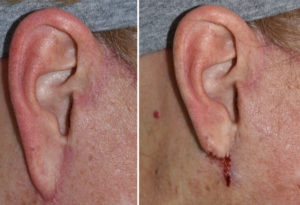Background: The basic concept of a lower facelift is one of tissue repositoning. Loose face and neck tissues are freed up and then repositioned up over the ears. The ear becomes partially buried under this flap of skin of which the redundancy is trimmed and the full ear is re-exposed. This places a closure line in and around the ear on both its front and back side.
Another basic tenet of facelift surgery is to not have excessive tension on these ear suture lines. Tension is the enemy of the desired result of a fine line scar. This is accomplished by SMAS flap elevation and repositioning and only removing skin that is not pulled back too tight.
When the facial skin is pulled too tight and over resected the tension on the ear can cause scar widening. But at the earlobe, which has no cartilage support, the earlobes can become stretched and elongated themselves. This is known as the Pixie Ear deformity and is not rare. As skin tension relaxes over time the earlobe becomes elongated over months after the surgery.
There are different techniques for correction of the Pixie Ear deformity, most of which employ the re-elevation of the facial flaps in varying amounts based on how significant the ear deformity is.
Case Study: This 65 year-old female had a secondary lower facelift four months previously after having an initial facelift dine eleven years before. She had a Pixie Ear deformity from the first facelift and it did not become adequately corrected during the second one..

The direct approach to correction of the Pixie Ear deformity after facelift surgery is the most effective and simplest to perform. It has no risk of recurrence and involves no recovery. Its tradeoff is the visible vertical scar down from the earlobe. But in the older patient thus may not be a significant aesthetic concern.
Highlights:
1) Excessive tension on the lower ear can cause the earlobe to lengthen over time.
2) The direct approach to correction of the pixie ear deformity is the simplest and most effective
3) Direct earlobe reduction of the pixie ear deformity will leave a fine line scar in its wake.
Dr. Barry Eppley
Indianapolis, Indiana


